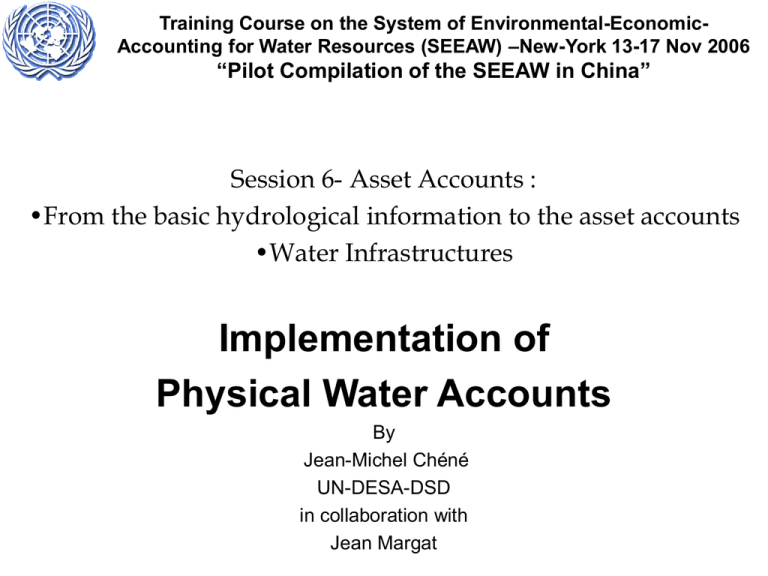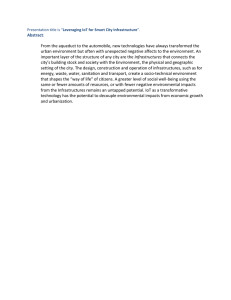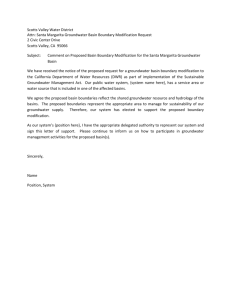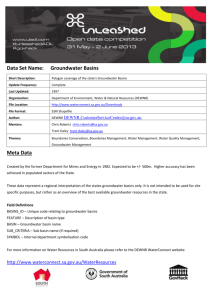Training Course on the System of Environmental-Economic- –New-York 13-17 Nov 2006
advertisement

Training Course on the System of Environmental-EconomicAccounting for Water Resources (SEEAW) –New-York 13-17 Nov 2006 “Pilot Compilation of the SEEAW in China” Session 6- Asset Accounts : •From the basic hydrological information to the asset accounts •Water Infrastructures Implementation of Physical Water Accounts By Jean-Michel Chéné UN-DESA-DSD in collaboration with Jean Margat Objective GLOBAL INFORMATION AND DEBATE NATIONAL WATER POLICY Decision Making Reporting Water Management Integrated Information Measurements Analysis of policy needs Monitoring Water Accounts, Models GIS, Evaluat.qual. Implementation of Physical Water Accounts 1- Identification of needs and of the base line 2-International experiences 3-Implementation principles 4- Hydraulic Infrastructures Asset Account 5-Proposed next steps 6-Conclusions and recommendations 1- Identification of needs / Base line The lack of basic data and statistics, both qualitative and quantitative, Constraints to overcome : 1. information is either not available or often scattered 2. observation networks have often deteriorated in many parts of the world over the past decade and, in most developing countries, databases are inadequate; 3. 4. lack of financial and human resources, poor information sharing; water resources data is often collected in isolation of other relevant socioeconomic and environmental variables at the basin level; 5. data are collected and compiled using alternative definitions and classifications across the various data producers, thus rendering the existing datasets incomparable; Data collection and processing Usually sources of data comes from : • monitoring by hydro-meteorological services; • observations made by science and research institutes in the in the field of geography, geodesy and hydrology; • regular survey of withdraws, consumption and discharges • special household surveys • annual technical - economical report by basin, regional, communal services…. • Data per unit of production • Socio-economic data by economic unit • …………………………..IT……. DIFFERENT LEVELS OF HYDRO DATA COMPILATION Table Asset accounts Territory: Unit: hm3 Period: Matrix of flux within the environment Evapotranspiration Precipitation Atmosphere Territory of Reference Inland Water Resource System upstream basins and aquifers outside the territory of reference Surface water (rivers, lakes, snow ice and glaciers) Soil water Natural transfers Inflows Outflows infiltration lt in Sa s tru Groundwater infiltration ion Ou tflo w downstream basins and aquifers outside the territory of reference s Sea Returns Abstraction Sea Economy Matrix of natural flux within the environment Matrix of manmade induced flux within the environment Matrix of flux within the Economy Atmosphere Territory of Reference Returns Returns Abstraction Returns Abstraction In situ use of precipitation Abstraction Inland Water Resource System Evapotranspiration Sea Sea Re Sewage and refuse disposal... Ab n io ct ra st R et ur ns s turn Households Other Industries (incl. Agriculture) RoW Economy Imports Collection, purification and distribution of water; Transport via pipeline RoW Economy Exports Economy Matrix of flux within the Economy GPS, digitalization, GIS and classification of basic Infrastructures Aggregation and exchange of data DIFFERENT LEVELS OF DISAGGREGATION NATIONAL BASIN PROGRAMMATIC UNIT Table1 Subject 1 Table1 Subject 1.1 Table1 Subject 1.1.1 Table1 Subject 1.1.1.1 2-International experiences • • • • Nordic countries Australia Developing countries France 1981 GERMANY 1995 Water flow between nature and the economy, and within the economy , mn m³ Abstraction from nature Foreign and rain water 5,273 43,636 Ground, spring, and surface water, bank filtrate 48,909 6,448 8 Water supply 1)6,448 Distribution 47 2,339 124 Production/ consumption 37,141 3,266 8 711 Final consumption of households Other production 5,273 3,313 39,480 285 250 1,635 152 2,930 Waste water disposal 329 9,962 4,689 Disposal Exports less imports of water 35,801 1,715 Water incorporation into less water removal from other materials 177 Discharge into nature 48,724 Foreign and rain water 5,273 Losses in water distribution 711 Evaporation and other 2,000 losses Waste water indirectly discharged 4,689 Waste water directly discharged 36,051 MOLDOVA : HYDROLOGICAL SYSTEM FLOW ACCOUNT 1994 INLAND WATER ACCOUNTS / RESOURCE ACCOUNTS IN RAW QUANTITIES T2 - HYDROLOGICAL SYSTEM FLOWS ACCOUNT (INPUT-OUTPUT TABLE) YEAR : 1994 - COUNTRY : REPUBLIC OF MOLDOVA - UNIT : Mm³ T2A - TOTAL INPUT AND OUTPUT TO THE (FROM THE) HYDROLOGICAL SYSTEM w1 Soil & vegetation f11 Precipitation f12 Outside natural influents f311 Returns of lost water (incl. leaks) f312 Returns of waste water f321 Irrigation f23 A SPONTANEOUS INTERNAL INPUT D TOTAL INPUT TO THE HYDROLOGICAL SYSTEM f23B SPONTANEOUS INTERNAL OUTPUT f34 Primary withdrawals (extraction…) f16 Evapo-transpiration f131 Natural outflows towards territories (regions, basins…) f132 Natural outflows towards the sea w2 w3 Groundwater Snow & ice 13635,5 " w4 Lakes & reservoirs 210,2 w5 TOTAL Rivers 168,2 14013,9 9000,0 10100,0 81,1 1763,3 1844,4 310,0 2123,0 2453,0 13054,5 29250,3 65,5 20,0 2453,0 264,5 2452,6 2717,1 332,8 13472,0 10000,0 11379,1 1100,0 218,0 218,0 621,0 14256,5 621,0 1709,1 2367,5 210,2 12723,3 415,9 1379,1 E WITHDRAWALS AND FINAL OUTPUT F CHANGES IN STOCKS (NET ACCUMULATION OF WATER) = (H - E) G TOTAL OUTPUT FROM THE WATER SYSTEM AND NET ACCUMULATION = (f23B + E + F) H GLOBAL AVAILABLE ANNUAL RESOURCE = (D - f23B) 12723,3 1643,6 -834,3 415,9 12785,4 27568,2 -205,7 249,1 -770,9 14256,5 1709,1 210,2 13054,5 29250,3 11889,0 1643,6 210,2 13034,5 26797,3 T2B - INTERNAL TRANFERS BETWEEN HYDROLOGICAL SUB-SYSTEMS w1 to recipient from origin w1 Soil & vegetation w2 Groundwater w3 Snow & ice w4 Lakes & reservoirs w5 Rivers f23 A SPONTANEOUS INTERNAL INPUT Soil & vegetation w2 Groundwater w3 w4 Snow & ice Lakes & reservoirs 310,0 " " " f23B w5 Rivers SPONTANEOU S INTERNAL OUTPUT 2057,5 2367,5 65,5 65,5 2123,0 2453,0 " 20,0 330,0 20,0 France’s Physical Water Account 1981 France’s Physical Water Account 1981 o Pilot Water Accounting in a sub-basin in Morocco DEMONSTRATION PROJECT IN MOROCCO Phase 1: (implemented) • Identification Mission • National workshop – Training on WA • Pilot compilation of water resource accounts for one subbasin • Validation workshop with stakeholders Phase 2: ( still not implemented) • Resource mobilization … • Drafting of a guidance document (on-going) • Compilation of water resource accounts in the other basins and integration of the accounts at the national level • Preparation of a publication on the results of the project to be used as an example for other countries. ENABLING INSTITUTIONAL ENVIRONMENT Results on the pilot sub-basin • informational and methodological difficulties were encountered, mainly on the monetary account. • From a physical point of view, the SEEAW can, with a better intergovernmental coordination, be used for the compilation of the water accounts per basin. However, certain gaps in the data are observed related to the water quality, the ground water and to some assessments of water uses. The regional workshop on Integrated Water Resource Accounting in Morocco was organized by the Government of Morocco and UNDESA (DSD- SD) has recommended : • To expand the pilot compilation at the sub-basin level to the whole Oum-Er-Rbia river basin, and to extend, after validation at the national level, the water accounts to all river basins within Morocco, with the objective of establishing a national satellite water accounts to be obtained by aggregation; • To take the necessary steps to institutionalize the National Committee for Water Accounts; • That the Ministry in charge of Water recognizes the water accounts as an important and useful tool for the monitoring and integrated management of water resources in Morocco and establish the implementation of water accounting as a priority in future action programmes of River Basin Agencies, as well as in its own training and action-research programmes at the central level; • To prepare, with the support of UNDESA a project on building capacity in the country to ensure the successful implementation of water accounts; • To prepare a special study analyzing the institutional, technical and organizational issues for establishing water accounts by river-basin in the whole country; • To establish water accounts within the regular programme of work of the government administrations, businesses or offices dealing with water, and in particular of regional administrations and River Basin Agencies. 3-Implementation Principles See the available paper on the “implementation of physical water accounts” Asset accounts (flows and stocks) of : • water resources and its utilizations; and, on an indicative basis (in Annex 1), • infrastructures. The following issues are addressed: – – – – – – – Place of the water accounts in the water information system; Methodological prerequisites; Elaboration of measured accounting data; Deduction of calculated accounting data; Preparatory documentation; Operation strategy and work organization; Means called upon. Methodological prerequisites • Reference territory – reference period – accounting unit • Two different type of data within tables : Measured data (from independent sources) Calculated data (dependent of previous data : summation, coefficients…) Preparatory documentation • General geography and cartography Total area of the reference territory / occupation of lands, General map with location of the main hydraulic infrastructures (dam reservoirs, in- outlets, diversion canals) and main utilization areas (agglomerations, industries, irrigation and drainage perimeter, collectors etc.). • • Isohyetal maps (average annual rainfall) with the location of measurement stations, and possibly a map with rainfall data on the year of reference. Hydrographic map Watercourses ranked by the average size of its trenches; Location of lakes and reservoirs; Location of possible humid zones; Location of discharge measurement stations (hydrometric) and of the sampling for the analysis. • • • • • • • • • Climatologic maps Hydro-geologic maps, with the representation of the main aquifer systems and classification of the outcropped lithologic areas. Soil maps showing the extension of cultivable land, grazing land and forest areas Hydro-climatologic data Hydrographic statistics Hydrologic data Hydrographic data (Hydro-chemical data on the quality variables of water: for quality accounts) Hydraulic data – – – • Characteristics of all relevant hydraulic infrastructures for water production Area of each reservoir (on average) or the relation between area and water level (graph) in case of significant variation; and table of average daily or monthly areas for the calculation of losses due to evaporation. Water volume of each reservoir at initial and final date. Volumes of possible dam releases and losses by infiltration of each reservoir. Hydro-economic data on the ex-situ usage Elaboration of “measured” accounting data • Initial and final stock • Exterior input and output from the environment • Internal transfers within the environment, resulting from the dynamics of the resource system or induced by manmade arrangements, • Exchanges between the environment and the economy • Internal transfers between different categories of economical entities Deduction of “calculated” accounting data Examples : 1) By summation - examples : – the stocks of soil water and of groundwater are calculated using water balances; – precipitation of soil water calculated by difference – the transfers of soil water to rivers and to groundwater. – Exchanges between the environment and the economy deducted from the “measured” data from the ad hoc rows in Supply and Use Tables 2) By Use of coefficients to get “calculated” data from “observed” data. Example of table of coefficients Operation strategy and work organization 1. 2. Preparatory documentation, Elaboration of the “measured data” and the ad hoc filling in of the different tables and matrixes. 3. Calculation of the “calculated data” 4. Summation of the water use and water supply tables 5. Final calculation into table 1: “Asset accounts (water resources stock; inflow-outflow Soil water evapotranspiration = Precipitation – Transfer to rivers and groundwater 6. Verification and adjustment of the general equilibrium of each accounting table. Difficulties in creating an equilibrium can raise doubts on the validity of certain data and lead to a revision of the figures and may require to go back to the sources. Means called upon. • Political will • Institutional environment • • • • Experimental stage. Legal environment Human resources An adequate level of subsidiarity. • • Adequate educational programs must be conceived Communication • Distribution of the results The same tool can also be used to perform long-term simulations on the basis of collectively chosen scenarios. • Financial means and sustainability • Monitoring and evaluation 4-Infrastructures Asset Account Schematic presentation of the proposed hydraulic infrastructure asset account for each type of infrastructure and group of age (residual value / monetary account) : Ex of groups of age New Infrastructures : 0-5 ; 6-10 ; 11-25 ; 26- infinity Stock age group X Functional units Breaking down of infrastructure Stock age group X Dysfunctional units Other increase of infrastructure Other increase of infrastructure Rehabilitation of infrastructure Aba ndon ing of infrastr ucture Other decreas e of infrastr ucture Aba ndon ing of infrastr ucture Other decreas e of infrastr ucture benefits of building an hydraulic infrastructure asset account Especially evident for developing countries (MDG) . Example of indicators that can be derived from this new kind of asset table : • progress in number of population having effectively access to safe water supply (geographic distribution of this indicator and mapping) • progress in number of population having effectively access to basic sanitation (geographic distribution of this indicator and mapping) • above progress of impacts in relation with quality of maintenance and services • progress in water quality in relation with the stock of operational waste water treatment stations ---> policy monitoring Progress in water use efficiency / new hydraulic infrastructures • • evolution of the value of the stock of each type of infrastructures versus costs of investments versus economic, social and environmental impacts. • One key basis for measuring progress towards SUSTAINABLE DEVELOPMENT 5- Proposed next steps Recent recommendations of CSD-13 (04-2005) : “…develop and strengthen national monitoring systems • Establishing and managing water information systems; • Installing networks for monitoring water resources and quality; • Standardizing methodologies and developing monitoring indicators; • Disseminating information to relevant stakeholders.” 5- Proposed next steps 1- Technical Cooperation arrangements : at the request of the Gvt an advisory mission of DSD can be organized. 2- Drafting of a UN guidance document on implementation in practice. The document will provide hands-on guidance on how to compile the accounts on the basis of the experience gained in the compilation of the accounts for some pilot sub-basins. The document would serve as a training tool for the compilation of the accounts in the other basins of the voluntary country, with the support of existing institutions, institutes and organizations, at all levels, including basin agencies when available. It could be used later on as a training tool between developing countries (South-South cooperation) within an UN framework. 6 Conclusions and recommendations • Integrated water accounts, when disaggregated and when expanded (infrastructures, social and environmental dimensions) should constitute a central and powerful part of a national integrated water information system. • Within a national policy and strategy, effective decisions and actions for sustainable water development and management can mainly be conducted at the district and main river-basin levels within a country. This calls for the collection of data, and use of water accounts, at those basin levels, with participation of several administrations and contribution of generally fragmented databases. • The regular use of GIS and of scientific hydro-system modeling (updated each 5 years) can be a necessity, as well as targeted researches on distributed “coefficients”. • Simulation of futur development scenari by using the structure of water accounts could be easily explored, when built and reliable.






